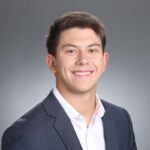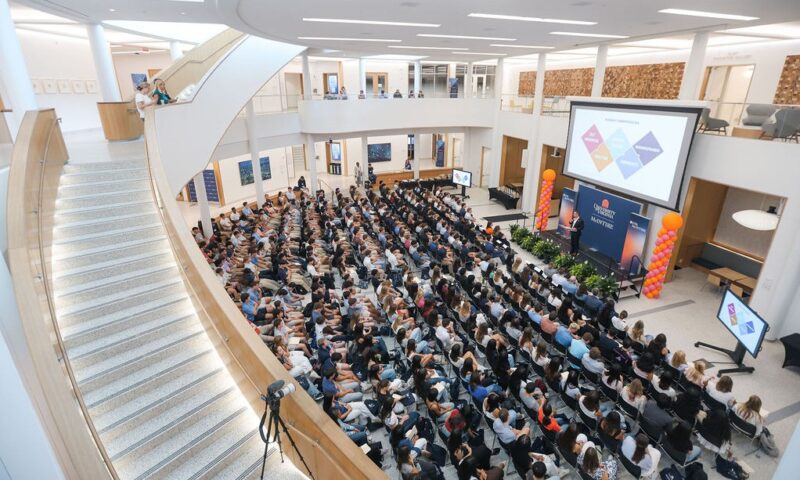Adapting and applying academic knowledge to real-world situations have always been central to the McIntire learning experience. For decades, third-year students have been primed for the challenges of business careers through the School’s hallmark Integrated Core curriculum. In Professor Paul Seaborn’s Management Consulting and Advisory Services course, that interaction takes on additional levels of complexity, requiring undergrads to cultivate working relationships with clients of their own choosing.
By offering a broad overview of the management consulting profession, the course equips both McIntire and non-Commerce third- and fourth-year students with relevant skills for careers in the consulting sector, as well as a foundational base for working in various fields across business, politics, and nonprofit endeavors.
Yet the nuts-and-bolts of the course is only one part of the equation: Seaborn’s proactive and supportive teaching style stands out to his students. Further, his introduction of a consulting project tackled by student teams stands as an essential component of the curriculum.
“I joined UVA and McIntire in fall 2019 and immediately began teaching COMM 4660: Management Consulting and Advisory Services,” says Seaborn. “One of the biggest changes I made upon taking over the course was to make a real-world consulting project the final course project.” The hands-on experience propels students into situations where they must diagnose problems, propose actionable solutions, engage with clients, and adapt to dynamic business needs—a taste of the nuanced reality of consulting.
The Project Experience
The course’s major consulting project comprises several steps designed to simulate a real-world consulting environment. Student teams are tasked with identifying a project client, frequently leveraging personal networks within the UVA community and beyond. Potential clients range from established local businesses to nonprofit ventures and startups. The project’s scope often focuses on various business strategies such as competitive strategy, marketing, or organizational behavior.
Prior to pursuing his PhD and becoming a professor, Seaborn spent eight years working in IT and strategy consulting; that experience informed his approach to the course project. “UVA students are very capable, and some arrive in my class with prior consulting-related experiences through other coursework, involvement in student organizations, and internships,” notes Seaborn. “So it was important to me that the projects be student-led from start to finish, providing additional challenge and an opportunity to take on roles that are generally not given to entry-level consultants.”
Alex Pentimonti (McIntire ’25) recounted her team’s collaboration in the fall 2024 semester with the Comm School alumnae-founded startup College Contact, launched by Class of ‘23 graduates Leah Guesman and Sophie Smith. Guided by Seaborn, Pentimonti’s team devised a campus ambassador program to enhance the startup’s outreach.
“It was really collaborative and iterative but also very directional,” recalls Pentimonti. “We were working within a clear framework.” She notes how Seaborn’s influence proved pivotal in reminding students to take a holistic approach to consulting, encouraging them to consider multiple facets of the business beyond the immediate problem.

Grace Scott
Grace Scott (A&S ’25) worked with Charlottesville’s Oakhurst Inn for her team’s consulting project. Initially met with differing expectations from the client, her team learned to quickly pivot and shift their problem-solving approach. “One of the things we were learning was that we didn’t ask enough questions up front, because we kept uncovering new information,” she notes. The experience taught her the importance of thorough client collaboration and communication, emphasizing the need for consultants to understand the client’s unique insights about their business, something she’ll take with her when she begins her career as a Business Analyst at Capital One.
Many Varied Learning Opportunities

Patrick Apel
The diversity in project clients and the teamwork necessary to complete it have become hallmarks of the course. Patrick Apel (McIntire ’25), who was Scott’s teammate, found that the hands-on project affirmed his interest in pursuing a consulting career. Apel reflects, “Our first deliverable was a proposal, and then [the Oakhurst Inn owner] gave us access to all of this financial data,” he says. The data better informed their revised proposal, but it reflected a deeper working relationship that Apel felt was a true collaboration based on his team gaining the client’s trust.

Sarah Durrer
Sarah Durrer (McIntire ’25), enrolled in the course in spring 2025, reiterated the significance of team collaboration in her consulting journey. Durrer’s team chose a family friend’s enterprise for their project, managing vendors and food trucks for a newly relaunched farmer’s market. Despite time constraints, they capitalized on structured problem-solving methodologies taught by Seaborn, like the TOSCA framework, which proved invaluable in progressing efficiently. She also appreciates the wide-ranging use for the decision-making skills she’s developed in the class. “They’re applicable to more than consulting,” she says. “l will definitely take that with me, collaborating with team members and different types of clients.”
Exposing students to a variety of businesses and nonprofit organizations is another benefit of the course’s project format. As Seaborn describes, “Students learn from working with their own client, but also through the experiences of the other groups and clients in their class. Hopefully, they also come away with an appreciation that these organizations are dealing with many of the same challenges as huge corporations but with far fewer resources.”

Zachary Fernandez
Zachary Fernandez (McIntire ’26), another current student, is navigating challenges with clarity in communication and problem-solving while working with a local wing and taco restaurant. His group was connected through friends who work at the establishment, but they were preparing to dig deep from the start in order to discover where they could offer the most value, since “it’s a pretty well-run business,” Fernandez explains.
Seaborn’s Positive Influence
Fernandez attributes his team’s readiness to Seaborn, his teaching methodology, and his ability to develop students’ technical and soft skills. His expertise and industry experience enrich the curriculum, offering students insights into real-world consulting scenarios.
“He taught us exactly how to deal with frustrated clients and with clients that are resisting help,” Fernandez says. “He was beyond helpful and able to answer a lot of individual questions.” Emphasizing Seaborn’s approachability and attention to student needs, he shares, “He’s extremely personable and always takes individual time with us.”
Apel praised Seaborn’s engaging teaching style: “He makes it more personal by telling stories from his professional career that link back to a lesson from class. It humanizes the learning experience.”
Scott appreciated his perspective on professionalism. “In consulting, and in higher education more broadly, there’s a focus on meritocracy and hierarchy. Professor Seaborn emphasized that working at a certain firm, going to a certain school, or having a certain degree aren’t what make a professional. It’s about your attitude. He showed that through his own teaching style,” Scott says, pointing out that she appreciated the importance he placed on integrity and commitment to one’s work, regardless of position. “As an assistant, you can be just as professional as a president.”
Seaborn urges his students to stay open-minded when engaging in any project—a lesson that Pentimonti says extends beyond work.
“He really encouraged us to take a really high-level, broad approach and not limit ourselves, even if we knew what solution we want to come to at the end. Professor Seaborn’s Consulting course taught many of us that you may expect one outcome or for a project to go a certain way, but it doesn’t—and you learn that things can work out differently,” she says. “I think that’s applicable to pretty much every course and everything you do in life: Sometimes you just have to take the journey in stride, open your mind, try an informed set of approaches, and see how it goes.”



